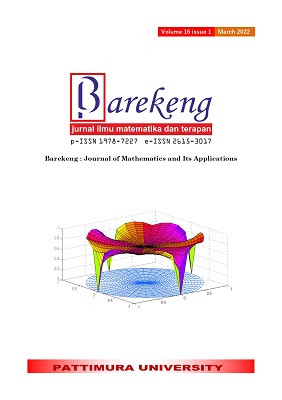FORECASTING RAINFALL IN PANGKALPINANG CITY USING SEASONAL AUTOREGRESSIVE INTEGRATED MOVING AVERAGE WITH EXOGENOUS (SARIMAX)
Abstract
Changes in extreme rainfall can cause disasters or losses for the wider community, so information about future rainfall is also needed. Rainfall is included in the category of time series data. One of the time series methods that can be used is Autoregressive Integrated Moving Average (ARIMA) or Seasonal ARIMA (SARIMA). However, this model only involves one variable without involving its dependence on other variables. One of the factors that can affect rainfall is wind speed which can affect the formation of convective clouds. In this study, the ARIMA model was expanded by adding eXogen variables and seasonal elements, namely the SARIMAX model (Seasonal ARIMA with eXogenous input). Based on the analysis that has been carried out, the prediction of rainfall in Pangkalpinang City, Bangka Belitung Islands Province can be modeled with the SARIMAX model (0,1,3)(0,1,1){12} for monthly rainfall and SARIMAX (0,1,2 )(0,1,3){12} for maximum daily rainfall. When compared with the actual data and previous studies using ARIMAX, the SARIMAX model is still better in the forecasting process when compared to the ARIMAX model. If viewed based on the AIC value of the SARIMA model, the SARIMAX model is also more suitable to be used to predict rainfall in Pangkalpinang City.
Downloads
References
BMKG, “BMKG Ingatkan Prospek Iklim 2021,” 2020. https://www.bmkg.go.id/press-release/?p=bmkg-ingatkan-prospek-iklim-2021&tag=press-release〈=ID.
Kompas.com, “Cuaca Ekstrem Diprediksi Landa Bangka Belitung Selama Tiga Hari ke Depan,” 2020. https://regional.kompas.com/read/2020/01/26/15181151/cuaca-ekstrem-diprediksi-landa-bangka-belitung-selama-tiga-hari-ke-depan?page=all (accessed Apr. 01, 2021).
Tempo.co, “Waspada! BMKG Tetpkan Babel Status Siaga,” 2021. https://nasional.tempo.co/read/1422975/waspada-bmkg-tetapkan-babel-status-siaga (accessed Mar. 30, 2021).
W. Teguh, “Peramalan iklim dan cuaca berbasis teknologi informasi,” no. March, 2020, [Online]. Available: https://www.researchgate.net/publication/339602291_Peramalan_Iklim_dan_Cuaca_Berbasis_Teknologi_Informasi.
S. Nurmita, Sugianto, and H. Wendi, “Analisa Arah Angin Terhadap Curah Hujan Menggunakan Equatorial Atmosphere Radar (EAR) dan Optical Rain Gauge (Org) Di Atas Kototabang Sumatera Barat,” [Online]. Available: http://repository.unri.ac.id/xmlui/handle/123456789/7888.
S. Renny Elfira Wulansari, “Peramalan Netflow Uang Kartal dengan Metode ARIMAX dan Radial Basis Function Network (Studi Kasus Di Bank Indonesia),” J. Sains dan Seni POMITS, vol. 3, no. 2, pp. 73–78, 2014.
M. L. Izza, D. Susilaningrum, and Suhartono, “… Penjualan Sepeda Motor Menurut Tipe dengan Pendekatan Autoregressive Integrated Moving Average with Exogeneous Input (ARIMAX) di Kabupaten Banyuwangi,” J. Sains Dan Seni Pomits, vol. 3, no. 2, pp. 176–181, 2014.
K. Wangdi, P. Singhasivanon, T. Silawan, S. Lawpoolsri, N. J. White, and J. Kaewkungwal, “Development of temporal modelling for forecasting and prediction of malaria infections using time-series and ARIMAX analyses: A case study in endemic districts of Bhutan,” Malar. J., vol. 9, no. 1, p. 251, Dec. 2010, doi: 10.1186/1475-2875-9-251.
Kongcharoen and Kruangpradit, “Autoregressive Integrated Moving Average with Exogenous Variable ( ARIMAX ) Model for Nigerian Non Oil Export,” Eur. J. Bus. Manag., vol. 8, no. 36, pp. 2010–2015, 2016.
A. R. Suryani, Sugiman, and P. Hendikawati, “Peramalan Curah Hujan Dengan Metode Autoregressive Integrated Moving Average With Exogenous Input (Arimax),” Unnes J. Math., vol. 7, no. 1, pp. 120–129, 2018.
D. Rosadi, Analisis Ekonometrika & Runtun Waktu Terapan dengan R. Yogyakarta: ANDI, 2011.
J. D. Cryer and K.-S. Chan, Time Series Analysis With Applications in R. Springer, 2008.
K. P. Chong, “Forecasting the Cocoa Black Pod Incidence in Sabah Using Arimax Model,” Malaysian Cocoa J., vol. 10, no. May 2018, pp. 39–48, 2018.
M. S. Hossain, S. Ahmed, and M. J. Uddin, “Impact of weather on COVID-19 transmission in south Asian countries: An application of the ARIMAX model,” Sci. Total Environ., vol. 761, p. 143315, Mar. 2021, doi: 10.1016/j.scitotenv.2020.143315.
Authors who publish with this Journal agree to the following terms:
- Author retain copyright and grant the journal right of first publication with the work simultaneously licensed under a creative commons attribution license that allow others to share the work within an acknowledgement of the work’s authorship and initial publication of this journal.
- Authors are able to enter into separate, additional contractual arrangement for the non-exclusive distribution of the journal’s published version of the work (e.g. acknowledgement of its initial publication in this journal).
- Authors are permitted and encouraged to post their work online (e.g. in institutional repositories or on their websites) prior to and during the submission process, as it can lead to productive exchanges, as well as earlier and greater citation of published works.






1.gif)



